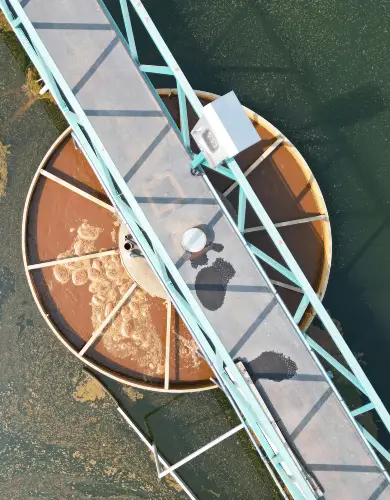Solar roof tiles: Inconspicuous PV technology
Installing solar energy in your home or business is no longer a question of “if” but “what to install.” As the Cambrian explosion of distributed solar technologies continues, solar roof tiles that seamlessly blend into the built environment are slowly but steadily going mainstream.
“No longer does installing solar have to look like you’ve been patching your roof.” – Anonymous
In this article, we introduce you to solar roof tiles (or “shingles” in America), explaining why they are crucial to the energy transition and, from a practical perspective, what is available in the UK.
Let’s dive in!
Contents
- Preface: The journey to solar roof tiles?
- What are solar roof tiles?
- How do solar roof tiles work?
- What are the pros and cons of solar roof tiles?
- What solar roof tiles are available in the UK?
- UK Solar Roof Tile comparison
- The future of solar roof tiles in the UK
Preface: The journey to solar roof tiles?
Before delving into the technology itself, it’s relevant to note why solar roof tiles are being designed and considered in the first place.
They are not more efficient or cheaper than regular commercial solar panels, so why would the mainstream choose them besides the novelty? Well, we believe it’s all about the seamless integration of renewable technology without altering the familiarity of our landscape.
We live in a world of exponential change, and most people reading this are likely struggling to keep up. Demographics have shifted, and most people in the UK and Europe are at least middle-aged, an age where stability and familiarity are highly valued.
Most global capital holders (those who decide to invest in solar or pay a premium for business energy renewables) are within this demographic, most of whom understand that change is necessary but are also growing tired of things looking and feeling different.
Most agree with the concept of clean energy, but still, a significant number of people in Britain would rather maintain the status quo than allow for the development of, for example, onshore wind turbines that “litter” the landscape.
In this sense, seamlessly (or perhaps discreetly) integrating renewables into the existing built environment is paramount to overcoming the human biases of the growing number of middle-aged and older populations – companies like Tesla are well aware they need to target to go mainstream.
Young people may have the ideas and enthusiasm, but the older generation has the financial resources. Solar roof tiles represent the reconciliation of these two contrasting realities.
What are solar roof tiles?
Solar or Photovoltaic (PV) roof tiles are solar panels designed to serve as conventional roofing materials like asphalt, clay, or slate tiles. They protect indoor spaces from the elements while generating electricity.
This combined functionality places them within emerging technologies known as building-integrated photovoltaics, a topic we hope to cover in a future blog post. This technology fills the market segment described in the preface.
Several companies, including Tesla, Gb-Sol and GAF, offer various solar roof tile solutions, but only a few are available in the UK.
The nascent nature of the solar roof tiles industry means that not only is the technology still in the process of proving itself, but designs also vary widely and involve multiple trade-offs, including efficiency, power output, durability, and ease of installation, all of which negatively impact the final installation costs.
When were solar roof tiles invented?
Solar roof tiles have existed for almost 20 years (as “shingles”), becoming commercially available in the US through Powerhouse Solar System in Colorado.
The fact that solar panels are black-coloured and robustly constructed makes them easily adaptable for this utility. However, the technology has become more widely available over the last few years.
Tesla entered the solar shingle industry in 2016 but unexpectedly faced multiple setbacks, allowing its competitors to catch up rapidly (and some argue, perhaps, to permanently overtake it).
For instance, GAF Materials, one of the largest suppliers of roofing materials in the U.S., has recently unveiled a product that can be rapidly installed using a nail gun, not to mention products elsewhere like SlatePV that mimic the typical slate roofs found in places like Wales.
How do solar roof tiles work?
These solar roof tiles work in the same way as solar panels. They harness the photovoltaic effect to generate electricity by absorbing solar radiation during the daytime.
However, instead of being installed as separate components, solar roof tiles become the roof, serving as a building’s upper barrier against the elements.
Solar roof tiles must pass stringent durability tests to withstand heavy impacts such as hail or falling branches. They must also exhibit weather resistance to prevent water ingress during all possible weather conditions.
Each roof tile or panel typically has a connection cable beneath it, which may require space between the roof and any underlying breathable or insulation membranes covering the ceiling to accommodate these electronics.
While some roof tiles are assembled like Lego pieces on plastic structures, others are custom-made in a factory and assembled on-site– there is certainly a lot of diversity.
💡 Fun fact: Solar panels can generate negligible amounts of electricity from moonlight, which is reflected sunlight that is 400,000 times weaker!
What are the pros and cons of solar roof tiles?
Like everything else, there are trade-offs regarding solar roof tiles.
Here are the pros and cons of solar roof tiles when compared to regular solar photovoltaic panels:
Pros:
✅ Aesthetics: Beauty is subjective, but a widely held opinion is that seamlessly blending structures is visually more harmonious. This can also be useful in adhering to local solar panel permitting and regulations.
✅ Cost-effective refurbishments: If a roof needs replacement, installing solar roof tiles may present a cost-effective opportunity to make two improvements in a single job.
✅ No space limitations: Since roof tiles are smaller units, they can be fitted onto all roofing surfaces.
✅ Durability: Solar roof tiles are designed with extreme durability in mind, as is reflected by the typical 25-year warranties offered by many manufacturers and installers.
✅ No need to dismount: If anything happens under traditionally mounted solar panels, the panels and the roof must be removed to gain access. With integrated solar tiles, this is not necessary.
✅ No debris and wildlife buildup: The sealed air gaps beneath solar roof tiles prevent debris accumulation or the formation of habitats for birds and small mammals.
✅ Lightness: Solar PV tiles are generally lighter in weight than regular slate or clay tiles, reducing the structural loads on buildings and enhancing overall safety.
✅ Fire-proof: After the Grenfell fire in London, perceptions regarding the fireproof qualities of cladding and roofing materials have changed. Solar roof tiles are fireproof, making them a suitable choice.
Cons:
⛔ Cost: Being a nascent, less efficient technology, solar roof tiles are more expensive on a cost-per-watt basis than regular solar panels. See our full article on costs for commercial solar panels.
⛔ Efficiency: Solar roof tiles are less efficient than conventional solar panels because they must compromise performance for aesthetics, sizing, durability, and usability.
⛔ Installation costs: Roof tile installations are often the costliest part of the process due to labour and time requirements for this more complex job.
⛔ Hard to retrofit: Fully retrofitting solar roof tiles is costly and complex, making this more suitable for new buildings or refurbishments.
⛔ Unproven tech: There is still uncertainty about real-life performance as the technology has not had time to prove its credentials. Being nascent also means there are few options available in the market.
What solar roof tiles are available in the UK?
As of the time of writing (28th September 2023), there are six solar roof tile companies in the UK. Some are only manufacturers; others make them and install them. Here’s the list:
See our comparison table for the main differences between them.
❗ Note that some of the most innovative solar roof tiles, such as Tesla’s Solar Roof or GAF Energy’s Timberline solar shingle, are only available in the U.S.
GB-Sol PVSlate and Infinity Roofs
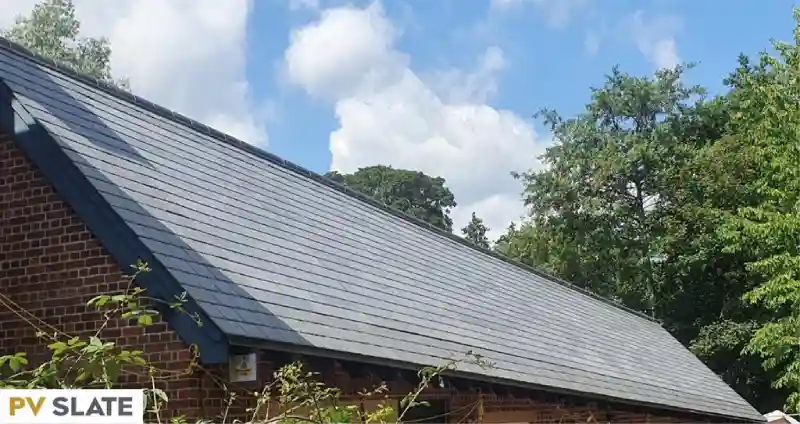
GB-Sol manufactures its photovoltaic panels in their factory near Cardiff and installs their systems all over the UK. They offer three roof tile solar products:
- PVSlate: A photovoltaic (PV) blue-grey slate tile that mimics the classic roofing material for many homes in the UK. It’s an MSC-certified roof tile, allowing the property to export any surplus power to the national grid and participate in electricity arbitrage strategies. See the product brochure here.
- Infinity Solar Roofs: Large PV glass tiles designed to cover the entire roof area from edge to edge. These large solar tiles are mounted on structural welded aluminium frames, providing the system with stability and a 25-year warranty. See details here.
- Integrated Solar Roofs: A combination of solar panels and roofing – this simple setup places high-efficiency solar panels in a tileless section of the roofing system, replacing regular tiles. This cost-effective option blends in and performs well, avoids debris build-up common in regular panel installations, but lacks the complete seamlessness of a fully tiled solution.
GB-Sol has a long track record in manufacturing and installations and is the only fully end-to-end solution provider of British solar roof tiles.
Nulok
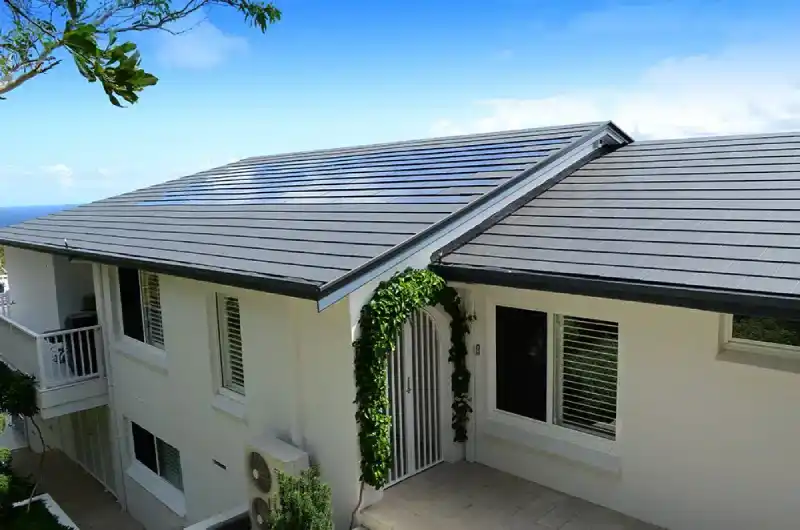
Nulok is an Australian-headquartered ‘modular’ roofing company that installs tiles using their unique ‘Nulok’ interlocking grid system, allowing rapid installation and easy solar panel maintenance
They operate globally and now incorporate ‘Solartrix‘ solar tiles (a Chinese make) into their modular installation system. This means the tiles can be easily installed and replaced if necessary.
Anyone with a Nulok system can quickly replace their existing roof tiles with solar tiles for a lower cost.
Marley SolarTile (Roof-Integrated PV)
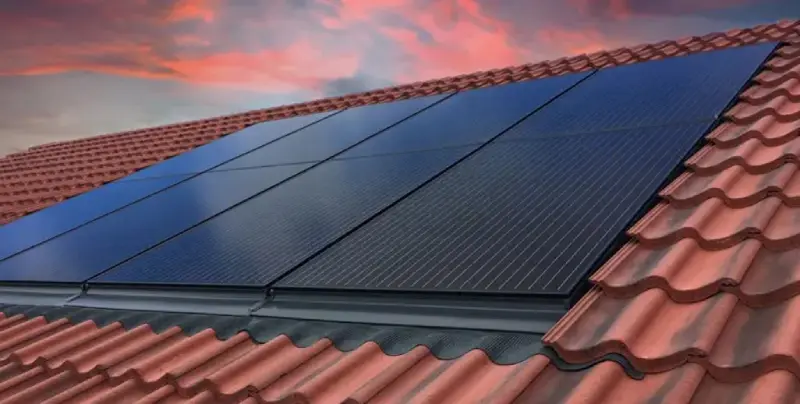
The Marley SolarTile blends traditional solar panels and solar roof tiles, akin to GB-Sol’s integrated solar roof. This solution maintains a traditional panel’s size, appearance, and performance but is directly mounted onto a tileless roof section.
The SolarTile is weather-resistant and relatively inconspicuous as it integrates directly into the roof structure. However, its size, colour, and texture distinguish it from the adjacent roofing material.
Marley offers two-panel options: 405W or 335W monocrystalline silicon panels.
GSE (Roof-Integrated PV)
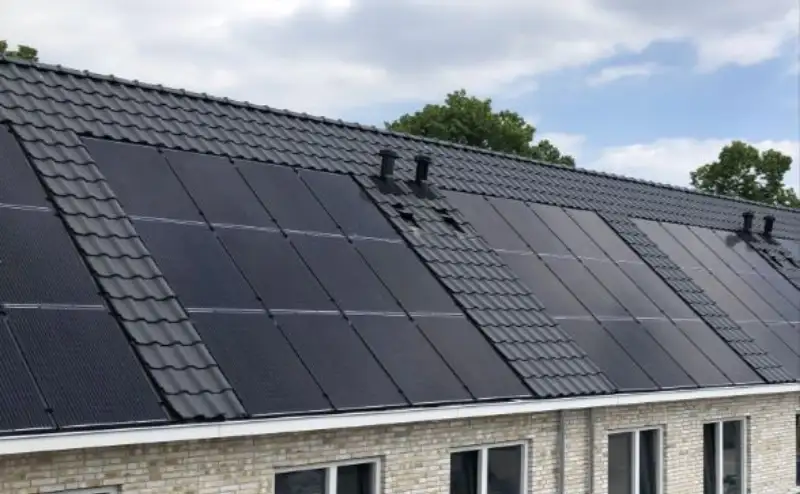
This French manufacturer has received certifications from various European bodies and holds MCS Certification, allowing for the export of electricity back to a local electricity distribution network operator.
GSE’s solution is also an integrated in-roof PV, similar to the Marley SolarTile. This means that it still resembles a solar panel but is integrated within the roof, performing the same protective function as roof tiles– essentially, acting like large roof tiles.
GB-Sol installs these GSE panels as part of their integrated roof systems.
IRFTS Easy Roof Evo (Roof-Integrated PV)
A cost-effective solar roofing system (similar to GSE and Marley, this is an integrated roof PV system, not a traditional tile-sized solution). It is based on a standardised yet straightforward plastic trays and frame clamps system.
It is one of the most budget-friendly in-roof solutions, and, like GSE, it is manufactured in France.
UK Solar roof tile comparison
We have researched various online resources to compile some of the most crucial information in one place for your convenience.
The following table details warranties, estimated pricing, and certifications for the solar roof tiles available in the UK market.
| Solar Roof Tile | Warranty | Power Warranty (% Capacity) | Approx Pricing (£/kW) | MCS-Certified? |
|---|---|---|---|---|
| GB-Sol PV Slate | 25 years | 90% @ 10 years 80% @ 25 years | £2,100 / kW | Yes |
| GB-Sol Infinite Roof | 25 years | N/A | N/A | Yes |
| GB-Sol Integrated Solar Roof | 25 years | N/A | £1,800 / kW | Yes |
| Nulok (Solartrix Tiles) | 10 years | 90% @ 12 years 80% @ 25 Years | N/A | Yes |
| Marley SolarTile | 15 years | 80% @ 10 years 90% @ 25 years | N/A | Yes |
| GSE In-Roof system | 15 years | N/A | £1,400 / kW | Yes |
| IRFTS Easy Roof Evo | 10 years | N/A | £1,400 / kW | Yes |
The future of solar roof tiles in the UK
Currently, there is a global boom in solar technologies. Solar power stands out as the fastest-growing source of electricity worldwide, indicating that solar panels have found a solid product-market fit.
However, predicting which solar technologies will dominate the distributed solar power generation market remains challenging.
Will traditional solar panels be mounted on roofs due to their lower cost? Or will we witness a surge in photovoltaic technologies integrated into various parts of the built environment?
Roof tiles and in-roof systems possess the advantage of being more aesthetically pleasing.
Yet, will the costs decrease fast enough for the difference to become negligible? Will consumers truly recognise the added value of this seamless integration into their buildings?
How will Perovskite technology impact PV integrations in the future as we begin cheaply harnessing even reflected sunlight across a broader spectrum?
This question highlights the evolving and dynamic landscape of the energy sector as we navigate towards a more sustainable and decentralised energy future.
Extended Reading:
- Our guide to commercial solar panels
- Agrivoltaic Solar Farms – Farming meets solar!
- A guide to PV solar batteries
FAQs
Are solar shingles the same as solar roof tiles?
Yes! The word “shingle” is commonly used in the U.S. to describe what is known in Britain as “roof tiles”, but they are essentially the same thing.
Is the Tesla Solar Roof available in the UK?
No, the Tesla Solar Roof is not yet available in the UK at the time of writing (September 28th 2023). Their solution has experienced significant setbacks and delays since its launch in 2016, but it is still very likely to cross the pond over the next couple of months or years.
Are solar roof tiles more expensive than solar panels?
Yes, estimates indicate that initial installation costs are about double that of traditional rooftop solar panels. In a return on investment calculation, the replacement cost of business electricity rates from the mains supply is more expensive for solar roof tiles.
However, if your roof is due for refurbishment, it may become more economical to install solar roof tiles directly than replacing the roof and installing solar panels on top.
How long do solar roof tiles last?
Solar roof tiles are a new technology and do not have a proven track record of reaching their entire lifespan yet. However, based on the typical warranties installers offer, these systems are expected to remain functional for at least 20 to 25 years.
This longevity makes solar roof tiles a substantial long-term investment.
Are solar roof tiles a good investment?
Yes. We believe that any investment into renewable energy generation is a future-proof investment to protect businesses from fluctuating energy prices and any carbon premiums that may come from purchasing electricity from a business energy supplier.
Moreover, solar power generation systems gradually pay for themselves through reduced bills or buy-back programs like the Smart Export Guarantee with your electricity supplier.
However, it is crucial to select the correct manufacturer and installation company. Not only do they provide a long-term warranty that safeguards your investment, but the overall quality of their service plays a vital role in ensuring this is a sound investment.
Also, conducting proper due diligence and comparing the market for the best technology to meet your needs is essential. Despite its drawbacks, the lower cost of traditional solar panels mounted on roofs may suffice for many individuals.
Is there a minimum or maximum roof angle for roof tiles?
Yes, there is a minimum and maximum roof angle for roof tiles.
A minimum pitch is necessary to ensure the required drainage and prevent condensation from forming behind the panels, especially during winter. A minimum inclination typically starts at 10 degrees, with many designs requiring at least 20 degrees.
Conversely, there is a maximum pitch to consider, as excessively steep angles can negatively impact the panel’s performance. Maximum inclinations typically do not exceed 45 degrees, as beyond this point, the panel’s power rating significantly decreases.

